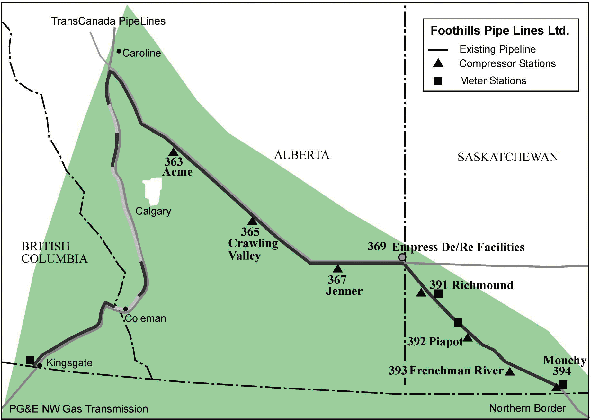Annual Report for Fiscal Year Ended March 31, 2013
Table of Contents
Overview
The Northern Pipeline Agency (NPA) was created by the Northern Pipeline Act (the Act) in 1978 to carry out federal responsibilities in respect of the planning and construction by Foothills Pipe Lines Ltd. (Foothills) of the Canadian portion of the Alaska Natural Gas Transportation System (ANGTS).
The project, also referred to as the Alaska Highway Gas Pipeline project (AHGP), is the subject of the 1977 Agreement between Canada and the United States of America on Principles Applicable to a Northern Natural Gas Pipeline (the Canada-U.S. Agreement).
Phase I of the project (the Prebuild) was constructed in 1981-82 for the initial purpose of transporting gas sourced from Western Canada to the United States (U.S.). The current flow capacity of the Prebuild is approximately 3.3 billion cubic feet per day (Bcf/d).
Figures 1 and 2 show the proposed route of the ANGTS in Canada and the U.S., as well as details of the existing Prebuild in Canada.
Phase II of the project would link the Prebuild with U.S. reserves at Prudhoe Bay in Alaska. Unfavourable economic conditions from 1982 to the beginning of this decade led to indefinite delays in the completion of the ANGTS and a prolonged period of low activity for the Agency. In 2008, TransCanada PipeLines Limited (TransCanada), which now owns Foothills, was selected by the State of Alaska under the Alaska Gasline Inducement Act to receive up to $500 (USD) million in State assistance to pursue an Alaska gas pipeline. This large-scale project of 2,762 km, would transport 4.5 to 5.9 Bcf/d of natural gas in a buried 48-inch, high-pressure pipeline from Prudhoe Bay, Alaska, to markets in Canada and the lower 48 states. Project costs have been estimated at $32-41 billion (2009 USD) by TransCanada.
On March 30, 2012, ExxonMobil, ConocoPhillips, BP and TransCanada announced that they are working together on a work plan to assess liquefied natural gas exports from south-central Alaska as an alternative to a natural gas pipeline through Canada. For its part, the Agency remains ready, engaged and prepared to lead the review of the AHGP, if and when the project moves forward.
Figure 1:
The Alaska Natural Gas Transportation System

Figure 2:
The Foothills Prebuild

Background Information
For further background information on the ANGTS and the NPA’s roles and responsibilities, reference may be made to the NPA’s Departmental Performance Report for the period ending March 31, 2013.
This report may be accessed through the Northern Pipeline Agency Web site at http://www.npa.gc.ca
The NPA can be contacted at:
615 Booth Street, Room 412
Ottawa, Ontario K1A 0E9
Telephone: 613-995-1150
Email: info@npa-apn.gc.ca
Key 2012-2013 Activities
The NPA continued to deliver on the responsibilities of the Government of Canada that are embodied in the Act and the 1977 Canada-U.S. Agreement by working with other federal departments, provincial and territorial governments, Aboriginal groups, the U.S. Federal Energy Regulatory Commission (FERC), the U.S. Office of the Federal Coordinator (OFC), and TransCanada.
An amendment to the Canada-Foothills Easement Agreement was approved in July 2012. This amendment consisted of an extension to the construction build date from 2012 to 2022. TransCanada will continue to pay an annual fee to the Government of Canada to maintain its easement rights.
The Agency continued its engagement with Aboriginal communities along the pipeline route in Yukon and British Columbia and maintained a record of its consultations. In addition, the Agency implemented a contributions program that resulted in increased capacity for Aboriginal groups to meaningfully engage in consultation activities with the Agency.
The Agency undertook several steps to manage its records and project information. This included working with the OFC to create a link to an electronic library containing an extensive listing of historical reports on northern pipelines.
To obtain needed resources, the NPA entered into inter-agency agreements with the Departments of Justice, Natural Resources Canada, Fisheries and Oceans and Health Canada, as well as the National Energy Board.
Organization
The Minister for Natural Resources, the Honourable Joe Oliver, is responsible for the management and direction of the NPA.
The Act provides for the NPA Deputy Head, called the Commissioner, to be appointed by Governor in Council. Currently, this position is held by the Deputy Minister of Natural Resources Canada, Serge P. Dupont.
Daily operations of the NPA are managed by an Assistant Commissioner, who is supported by twelve full time employees, employed as needed. The Act provides for independent regulatory decision-making by a Designated Officer who must be a member of the National Energy Board.
Through a Service Agreement, Natural Resources Canada provides administrative, financial, and information technology assistance to the NPA.
Expenditures
Sections 13 and 14 of the Act provide for an annual audit of the accounts and financial transactions of the NPA by the Auditor General of Canada, and for a report thereon to be made to the Minister and laid before Parliament. In compliance with these requirements, the report of the Auditor General of Canada for the year ended March 31, 2013, is reproduced as an appendix to this report.
The NPA requested and received a reference level of $3,347,403 for 2012-2013. Recoverable expenses for the year totalled $1,930,845. All of the Agency’s operating expenses are cost recovered from TransCanada.
Page details
- Date modified: